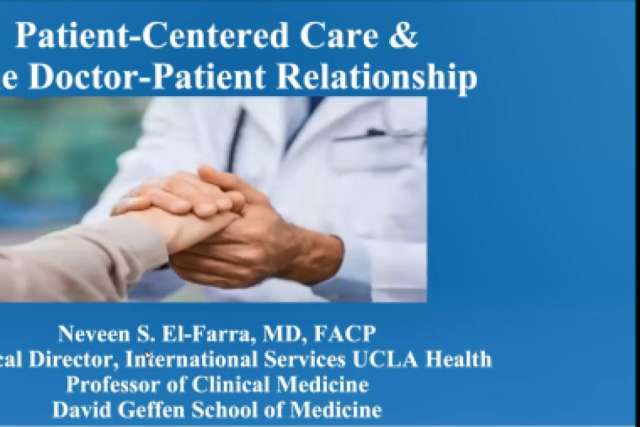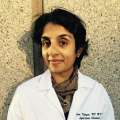Communication, compassion, empathy and mutual respect are key factors in doctor-patient relationships and are important aspects of how patient-centered care is practiced at UCLA Health.
This was the key message delivered at a virtual panel discussion presented by UCLA Health physicians to a group of physician leaders at the Guangzhou R&F Hospital, which is slated to become the first overseas affiliated hospital of UCLA Health when it opens in Guangzhou, China in 2022.
The Jan. 18 discussion was moderated by Dr. Neveen El-Farra, medical director of UCLA Health International Services, professor of Clinical Medicine and hospitalist in the Department of Medicine at the David Geffen School of Medicine at UCLA. Dr. El-Farra was joined by the following panelists:
Dr. Jason Napolitano, associate dean for Curricular Affairs and hospitalist at DGSOM; Dr. Tara Vijayan, assistant clinical professor in the Division of Infectious Diseases at DGSOM; Dr. Zhuang T. Fang, clinical professor and anesthesiologist at DGSOM; Dr. Misty Richards, assistant clinical professor in the UCLA Division of Child and Adolescent Psychiatry and the Department of Obstetrics and Gynecology; and Dr. Edward Ha, assistant dean for Clinical Education and hospitalist at DGSOM.
Dr. El-Farra emphasized that at UCLA Health, patients are at the core of what physicians do and that optimal care is delivered by working together as a team to better understand the patient’s goals for treatment.
“Similarly, at Guangzhou R&F Hospital, it is our hope that the patient will be at the center of care and that you all work together as a team to ensure the patients’ needs are met,” she shared with the panel.
Building relationships
“Evidence shows that spending time listening closely to patients and their families, engaging them in conversations about decision-making and responding empathetically to their concerns improves medical outcomes, promotes patients’ self-management, enhances the patient’s experience of being cared for and prepares them for their transition home,” Dr. El-Farra said to the group.
The UCLA Health physician panelists each shared their experiences in building strong doctor-patient relationships and how they incorporate UCLA Health’s patient experience philosophy, into each interaction. Their best practices include making eye contact with the patient, communicating information by using language that the patient can easily understand, and paying attention to the patient’s body language and tone of voice.

Dr. Napolitano also noted that it is essential for physicians to turn off their cellphones and pagers, ensuring that they are providing the patient with full attention when stepping into the patient’s room.
“Listen intently to what this individual is saying, tune into changes in their facial expressions, try to connect and get a good read on the person, what their fears are and what they’re hoping to accomplish,” he said.
As an anesthesiologist, Dr. Fang said his time with a patient is limited, so it’s important for him to gain their trust immediately. “We have to show we care, that’s most important. Also, I can’t overemphasize how important empathy is. During that conversation, I put myself in the patient’s position. Whether major or minor surgery, there’s a lot of anxiety and concern.”
Dr. Fang added that depending on the patient and the situation, using humor can go a long way in making patients feel more comfortable.
Diffusing anger
Occasionally there will be times when a patient is upset or distressed. Dr. Ha said he found the best way to deescalate such situations is to take the time to listen to the patient, let the patient share their frustration, and then apologize to the patient for the situation.
“Lastly, try to move their focus to the next steps,” Dr. Ha said. “Because we can’t change the circumstances, what can we do now to make their stay as devoid of suffering as possible? What things can we do to make them feel cared for, and how can we move their care forward?”
Dr. Vijayan recounted a situation with a patient in which she suggested that a complex procedure may be needed. The patient then only focused on this comment and became distraught. From this experience, Dr. Vijayan realized the impact her words may have on a patient. She needed to take a moment to sit down and listen to her patient before they could continue the appointment productively.
Time to process
Unfortunately, physicians often have to deliver unwelcome news to patients and their families. When delivering bad news to a patient, they must be sensitive, compassionate and give the patient time to digest the information.
“Never underestimate the power of pausing and slowing things down,” Dr. Richards said. “When patients and their families are given the time and space to process, then you can soon be in the place to discuss. It’s important to put your agenda aside, follow their lead, validate their experience, lower your voice and slow your speech.”
Dr. Napolitano suggested sharing the information in short, digestible pieces, letting the family process the information, and telling them you’ll check back with them later. “If the family has confidence that they can get ahold of you if they need to, it diffuses the situation and makes people more at ease.”
Cultural differences
During the Q&A session a question was posed by a physician at Guangzhou R&F Hospital: If a patient is diagnosed with cancer, should we tell the patient first or the family first?
The UCLA Health physicians agreed that the patient should always be at the center of all decision-making.
Dr. Fang, who has practiced medicine in the U.S. and China, said that although it is traditional in China not to tell patients they have a potentially terminal illness, it is important to be open with patients so they may participate in their own treatment decisions. “It may not be common practice in China, but I think it’s a good practice. I think that this would be a good practice for physicians in the Guangzhou R&F Hospital.”
Learn more about the International Services program at UCLA Health.
Jennifer Karmarkar is the author of this article.









